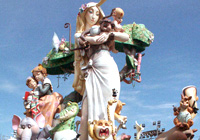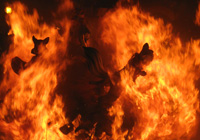At Enforex we always strive to provide our students with the best experience possible. That's why our school in Valencia stays open all year... yes, even during holiday seasons! After all, if you want to learn Spanish you shouldn't have to miss out on amazing cultural experiences like Las Fallas.
When you sign up for a Spanish course in Valencia, you can learn Spanish while discovering this truly one-of-a-kind celebration! Learn more about Spanish programs available all year round here: Courses in Valencia.
While there's nothing quite like seeing and experiencing for yourself the pyrotechnic displays, paella contests and towering papier-maché sculptures that have made Las Fallas famous around the world, you will find all sorts of interesting background information about the event in the lines below!
When and Where is Las Fallas?
Valencia's biggest celebration of the year takes off on March 15, when creators and builders scramble together to erect in a single day the elaborate fallas – emblematic and complex cardboard and paper-maché structures bearing a series of hand-made figurines called ninots, which climb high into the skies. The blazing finale comes just four days later, on March 19, during the feast day of Saint Joseph (who is also the patron saint of carpenters – hence all the care in the construction of the structures, see?), when the architectural works of art are burst into flames – yes, deliberately – to the cheers of thousands.
While there are many different versions of similar traditions across the entire peninsula to celebrate the feast day of Saint Joseph, commonly known in Spanish as the josefines, none of them come anywhere near the sumptuosity and dedication devoted to it in the Mediterranean city of Valencia, home to this festive, one-of-a-kind pyrotechnic display.


Las Fallas Traditions
Renowned artists, painters, and sculptors take great care in designing and constructing the enormous fallas – some tower up to 30 meters high! – that dominate Valencia's public squares and open spaces during the five-bacchanal every year. You won't be able to keep a straight face, admiring the masterfully-created, colorful fallas depicting celebrities, politicians, and current events of the past year in a toungue-in-cheek manner that sits halfway between a scathing satire and sardonic humor.
While awards and prizes identify the best fallas and their creators, these crafty individuals tirelessly work for months fully aware that the fruits of their talents and labors will meet their end as piles of discarded ash. At midnight on March 19 the city quite literally lights up as the 370 large fallas and 368 smaller infantile fallas burst into colorful flames.
While the week-long fiesta certainly revolves around the axis of the fallas and their eventual ignition, it also sparks the participation of the entire city. Valencian women pass through the city donning traditional regional costumes, music brightens the atmosphere, the cheer of "Olé" erupts at first-class bullfights, fireworks explode in the sky, and a general sense of merriment and partying fills the streets around the clock.
History of Las Fallas
Loosely connected in its most distant origin to a pagan celebration of the spring equinox, the appropriately colorful history of Las Fallas spans centuries. The fiery tradition that gave way to the magnificent celebration of Las Fallas traces its humble origins to 1497, when simple artisans and carpenters took a simple but long-lasting initiative:
During the winter months, they would be forced to spend long hours every day working by the flickering light of oil lamps, which hung, more or less precariously, from wooden structures. But with the arrival of the spring and the lengthening of days, lamps and their structures became unnecessary. That is when it occurred to some inspired, or maybe just clumsy worker, to send it all up in flames and let it burn. The celebration was immediately adopted to celebrate the arrival of warmer, longer days, and it was dedicated to San José (Saint Joseph), the patron saint of carpenters.
From that point onwards, it was all about having fun and getting creative when decorating these wooden structures, eventually even giving them human faces resembling characters of the neighborhood. Finally, the 18th century saw the next significant point on the timeline of Las Fallas, as groups of characters began appearing together to depict satirical and critical themes. Check out the final result of these carved makeshift "dolls" through the characters animating the impressive and ever-amusing fallas of today.


